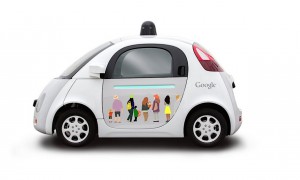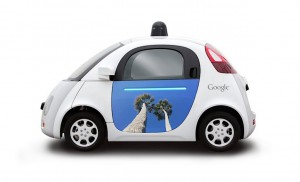
Google is looking for artists to help decorate its growing fleet of autonomous vehicles that are undergoing testing around California.
Think you have an artistic streak? Have an image in mind that might represent the car of the future or its impact on the world? Live in California? Google wants your help.
The Silicon Valley giant is just rolling out the first of its autonomous vehicle prototypes, two-seaters that look like a cross between an old Volkswagen Beetle and a tin can. They may incorporate the technology of the future, but pretty they’re not. And that’s something Google wants to fix.
It has launched a competition, dubbed a “moving art experiment,” aimed at transforming those bubble cars into rolling works of art. The official theme is, “my community, my neighbors.” Up to 10 different entries will be selected and the winners will, among other things, get to see their work rolling around the streets of Silicon Valley.
The project is a more democratic take, if you will, on the Art Cars program that BMW has run since the 1970s. The German maker has asked some of the world’s greatest artists to decorate the bodies of its street and race cars – a vaunted list that includes Andy Warhol, Frank Stella, Roy Lichtenstein and Jeff Koons.

Google is following in the steps of BMW and its Art Cars of the past with its new "rolling art experiment."
In this case, anyone 13 and older is eligible. They just have to get their entries into Google by Aug. 30 on a website dedicated to the Google Car project. Up to 10 entries will eventually be painted on the side of the vehicles and used on the company’s website.
As for those little, self-driving two-seaters, Google paired up with Michigan-based auto supplier Roush to come up with what will eventually be a fleet of those vehicles. They’re the next step in the technology giant’s autonomous vehicle program, Google already clocked what it claims is more than 1 million miles of testing in modified Toyotas and Lexus models.
(Google exec defends autonomous cars after 12th crash. For more, Click Here.)
Initially, the Google Car prototypes will come with standard controls but later during the program the maker plans to introduce vehicles with neither steering wheel nor pedals: just emergency shut-off buttons and microphones into which a passenger can enter a destination.
The new Google prototypes will incorporate the same basic array of radar and laser sensors used in the earlier vehicles, but they will more effectively hide the big LIDAR array that sat on top of the roof.

California artists are getting the chance to make their mark on the automotive world with Google's cars.
“They’re ultimately designed to work without a steering wheel or pedals, but during this phase of our project we’ll have safety drivers aboard with a removable steering wheel, accelerator pedal, and brake pedal that allow them to take over driving if needed,” noted Google in a blog post.
(Click Here for details about Ford’s plans for autonomous vehicles.)
“The prototypes’ speed is capped at a neighborhood-friendly 25 mph, and they’ll drive using the same software that our existing Lexus vehicles use — the same fleet that has self-driven over 1 million miles since we started the project. As we start to cruise around the neighborhood, we really want to hear what our neighbors think.”
That feedback could be critical – and not just to Google. The rest of the industry is watching closely to see how those vehicles will work. Google was embarrassed by recent reports that a number of its original prototypes have been involved in minor crashes – though it claims it was always the fault of the other driver.
Regulators will be watching closely to see how well the Google Cars perform. California is still tinkering with its new autonomous vehicle-testing program. At the moment, the regulations would not permit a vehicle to be operated without driver controls, so it will have to tweak the rules before those steering wheel-less models can be put into operation.
(To see more about why insurance companies aren’t ready for autonomous cars, Click Here.)
Google has stated that it does not plan to actually build its autonomous vehicles but instead hopes to find an automaker – or perhaps several – who might want to partner with the tech firm to share its self-driving technology.

Google’s recent unintended experiment where two autonomous vehicles almost crashed at highway speeds because one pulled into the passing lane just as the other one was about to do the same and cut the first car off proved to be a revealing experiment.
I’d be interested to know if any of these tin cans have been crash tested or if they even meet Federal safety std. requirements. You can bet that with no real crush zones that anyone inside these vehicles when involved in an accident is going to suffer from extremely high impact force to their body because the vehicle can’t gradually absorb or dissipate the crash force energy.
How about a big sign on it that says:
“______ Days Without an Incident. Of Course
No One has Hacked the Command Control….Yet”
…or a sign that says: My life is in God’s or Google’s hands.